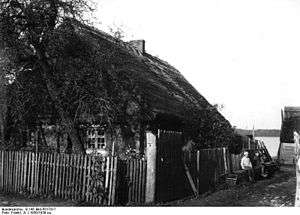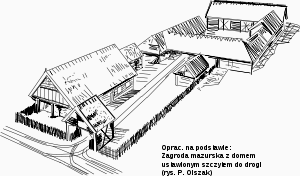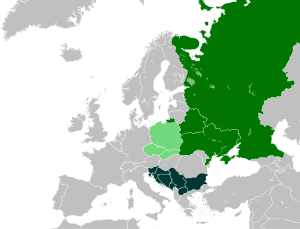Masurians

The Masurians or Mazurs (Polish: Mazurzy, German: Masuren) were a Lechitic sub-ethnic group in the present-day Warmian-Masurian Voivodeship, Poland. They were descended from Masovians (Polish: Mazowszanie; German: Masowier), Polish settlers from Mazovia who moved to Prussia during and after the Protestant Reformation, and who were primarily Lutheran.
In the 19th century, the Masuria region of East Prussia was named after the Masurians.
After World War II many Masurians were classified as Germans and expelled to West Germany or emigrated after 1956.
History
In the Middle Ages, the inhabitants of the Duchy of Masovia were called Mazur(z)y in Polish. Between the 14th and 17th centuries,[1] Polish settlers from northern Masovia moved to the southern territories of the Monastic State of the Teutonic Knights. (These lands had previously belonged to the Baltic Old Prussians, whom the Teutonic Knights had conquered in the 13th and 14th centuries.) The northern part of this state was soon settled by settlers from Germany and thus became Germanised. On the other hand, the incoming Protestant from the until 1526 independent Duchy of Masovia, partially Polonised a southern part of the Duchy of Prussia, later Kingdom of Prussia. Only in Allenstein, now Olsztyn, Catholics remained, because it belonged to the Prince-Bishopric of Ermland or Warmia.

Because of the influx of Masovians into the southern lakeland, the area started to be known as "Masuria" from the 18th century. During the Protestant Reformation the Masurians, like most inhabitants of Ducal Prussia, became Lutheran Protestants, while the neighboring Masovians remained Roman Catholic. In 1525 the Duchy of Prussia, a Polish fief until 1657, was founded from the secularized order's territory and became the first ever officially Protestant state. The small minority of Protestant Masovians in southern Catholic Masovia inside Poland emigrated later to Prussian Masuria. Masuria became part of the Kingdom of Prussia at the Kingdom's founding in 1701, and part of the Prussian-led German Empire at the Empire's founding in 1871.
Masurians referred to themselves in the 19th century as "Polish Prussians" or as "Staroprusaki" (Old Prussians)[2] Masurians showed considerable support for the Polish uprising in 1831, and maintained many contacts with Russian-held areas of Poland beyond the border of Prussia, the areas being connected by common culture and language; before the uprising people visited each other's country fairs and much trade took place, with smuggling also widespread[2] Some early writers about Masurians - like Max Toeppen - postulated them as mediators between German and Slav cultures.[2]
During the 1840s, the folklorist Gustaw Gizewiusz (Gustav Gisevius) collected Masurian folk songs which were later included in Oskar Kolberg's compilation Dzieła Wszystkie.[3]
Masurians in 19th and 20th centuries
According to Andrzej Chwalba or Henryk Samsonowicz Polish national activists and Masurians already were engaged in cooperation in 1848 when Poles from Pomerania supported Masurian attempts to elect their representative Gustaw Gizewiusz who defended the use of Polish language and traditions[4][5] For Piotr Wandycz the events of 1848 led to Polish national awakening in Masuria[6] In contrast Andreas Kossert writes that Polish interest in Masuria was inspired by a single poem published in 1872, "O Mazurach" by Wojciech Kętrzyński and that the unsuccessful attempts to create a Polish national spirit in Masuria were financed by Polish Nationalists from Posen (Poznan), Lemberg (Lviv) and Warsaw .[7][8] Beginning in the 1870s, Imperial German officials restricted the usage of languages other than German in Prussia's eastern provinces.[9] The German authorities undertook several measures to Germanise the Masurians or to separate them culturally from neighboring Poles by creating a separate identity.[10] After 1871 Masurians who expressed sympathy for Poland were deemed "national traitors" by German nationalists (this increased especially after 1918)[2] According to Wojciech Wrzesinki Masurians didn't receive any assistance or help from Polish movement at the time[11] According to Stefan Berger after 1871 the Masurians in the German Empire were seen in a view that while acknowledging their "objective" Polishness (in terms of culture and language) they felt "subjectively" German and thus should be tightly integrated into German nation-state; to Berger this argument went directly against the German nationalist demands in Alsace where Alsacians were declared German despite their "subjective" choice. Berger concludes that such the arguments of German nationalists were simply aimed at gaining as much territory as possible into German Reich.[2]
Before World War I many Masurians emigrated to the Ruhr Area, especially to Gelsenkirchen. Here, Masurians were not distinguished apart from the Poles and both groups were seen as inferior to Germans, culturally or even racially.[12] Despite those official efforts, German scholars usually considered Masurians as a group of Poles. In all German geographical atlases published at the beginning of the 20th century, the southern part of East Prussia was marked as an ethnically Polish area, with the number of Poles estimated at 300,000.[13] There was resistance among the Masurians towards Germanization efforts, the so-called Gromadki movement was formed which supported use of Polish language and came into conflict with German authorities; while most of its members viewed themselves as loyal to Prussian state, a part of them joined the Pro-Polish faction of Masurians.<ref name=Wang377> In general, popular resistance against linguistic Germanisation cannot be easily equated with anti-German sentiment or a strong attachment to the Polish national movement. Most of Masuria's small Polish-speaking intelligentsia remained decisively pro-Prussian, often adhering to an older, multi-ethnic model of Prussian identity, centred on loyalty to their king, not so much on the German language.[14][15][16] This ethnically, but not nationally Polish identity was a repeated source of consternation for Polish national activists,[17] and decidedly pro-Polish political parties and press never gained widespread influence among the general populace.[18] Richard Blanke summarised this long-standing attachment, going back to the late Middle Ages, as: „Masurians became Prussian, in other words, before the Bretons (not to mention the Alsatians) became French.“[19]
The Masurians evinced strong support for Germany during World War I.[20] In 1920 the League of Nations supervised the East Prussian plebiscite - with British, French and Italian troops stationed in Masuria - to determine the new border between the Second Polish Republic and German East Prussia. The plebiscite was organized by the local German authorities.[21] Polish ethnographer Adam Chętnik stated that the German authorities performed abuses and falsifications during the plebiscite,[22] and Stefan Berger writes that the Masurians were subjected to huge psychological pressure and physical violence by German side to vote for Germany.[23] Kossert admits irregularities during the referendum, but asserts that in general, its results truthfully reflected the overwhelmingly pro-German sentiment in southern East Prussia.[24] In Masuria proper the vast majority (99.32%) opted to remain in Prussia.[25][26] Attempts to create schools teaching Polish in interwar Germany were met with terror and violence[27]
Support for the Nazi Party was high in Masuria, especially in elections in 1932 and 1933.[28] Nazis used the Masurian dialect for their political rallies during the campaigning.[28] The government of Nazi Germany changed the names of several Masurian towns and villages from their original Slavic or Baltic Prussian names to new German names in 1938. During World War II the Nazis persecuted and killed Polish speakers in Masuria and imprisoned Polish teachers as well as children who learned Polish.[29][30] The Nazis believed that in future the Masurians as separate non-German entity, would disappear, while those who would cling to their "foreignness" as one Nazi report mentioned, would be deported.[31] Poles and Jews were considered by Nazis to be "untermenschen", subject to slavery and extermination, and Nazi authorities murdered Polish activists in Masuria, those who weren't killed were arrested and sent to concentration camps,[32]
In 1943 "Związek Mazurski" was reactivated secretly by Masurian activists of the Polish Underground State in Warsaw and led by Karol Małłek.[33] Związek Mazurski opposed Nazi Germany and asked Polish authorities during the war to liquidate German property after victory over Nazi Germany to help in agricultural reform and settlement of Masurian population, Masurians opposed to Nazi Germany requested to remove German heritage sites "regardless of their cultural value".[34] Additionally a Masurian Institute was founded by Masurian activists in Radość near Warsaw in 1943[35] Andreas Kossert regards these claims as a presumption completely disregarding the actual conditions of the Masurian people.[36]
Along with the majority of ethnic German East Prussians, many Masurians fled to western Germany as the Soviet Red Army approached East Prussia in 1945 in the final European campaigns of World War II. The post-war Potsdam Conference placed Masuria - and the rest of southern East Prussia - under Polish administration. Many Masurians who were classified as Germans were expelled with military force. After 1956 many who had remained in Poland emigrated to West Germany, as of 2003 approximately 5,000 Masurians still lived in the area, many of them as members of the German minority.[13] Speculations about the reasons of this emigration vary from the economic situation and the undemocratic - communist - system in Poland[13] to the shrinking prospect of a return of Masuria to Germany.[37]
Mazur remains the 14th most common surname in Poland, with almost 67,000 people bearing the name.[38] According to the ethnographer Adam Chętnik, the Masurians were most closely related to the Kurpie branch of the Poles.[22] A group of Masurians migrated south and became one of the main components of the Lasowiacy, who live in the northern part of the Subcarpathian Voivodeship.[39][40]
| District | 1861 (Census) | 1861 (Estimate) | 1890 (Census) | 1890 (Estimate) | 1910 (Census) | 1910 (Estimate) | 1925 (Census) | 1925 (Estimate) |
|---|---|---|---|---|---|---|---|---|
| Johannisburg (Pisz) | 82,4% | (90%) | 78,8% | (83%) | 68% | (77,9%) | 20,4% | (60-80%) |
| Lötzen (Giżycko) | 64,5% | (80%) | 50,6% | (65%) | 35,9% | (58,9%) | 4,4% | (25-40%) |
| Lyck (Ełk) | 78,6% | (85%) | 66,6% | (73%) | 51% | (68,9%) | 11,3% | (45-70%) |
| Neidenburg (Nidzica) | 81,6% | (87%) | 75,6% | (84%) | 66,6% | (80%) | 23,1% | (50-65%) |
| Oletzko (Olecko) | 57,7% | (75%) | 47,7% | (57%) | 29,6% | (51%) | 8% | (25-60%) |
| Ortelsburg (Szczytno) | 87,9% | (92%) | 78,1% | (85%) | 70,1% | (82,9%) | 30,4% | (65-75%) |
| Osterode (Ostróda) | 63,1% | (67%) | 54,3% | (63%) | 41,2% | (55,9%) | 11,7% | (25-45%) |
| Sensburg (Mrągowo) | 74,7% | (87%) | 62,2% | (72%) | 49,6% | (67,5%) | 12,8% | (40-50%) |
| Total | 74,4% | (83%) | 65,3% | (73,4%) | 52,4% | (69%) | 16,3% | (?) |
See also
| Wikimedia Commons has media related to Mazury. |
Notes
- ↑ Jerzy Jan Lerski, Piotr Wróbel, Richard J. Kozicki, Historical dictionary of Poland, 966-1945, Greenwood Publishing Group, 1996, p. 346, ISBN 0-313-26007-9 Google Books
- 1 2 3 4 5 Wang, Q. Edward; Fillafer, Franz L. (2007). The many faces of Clio: cross-cultural approaches to historiography. Berghahn Books. p. 375. Retrieved 31 January 2012.
- ↑ Kolberg, Oskar. Dzieła Wszystkie
- ↑ Historia Polski: 1795-1918 - Page 311 Andrzej Chwalba - 2005 Wiosną 1848 r. polscy działacze narodowi z Pomorza nawiązali kontakty z Mazurami.
- ↑ Polska, losy państwa i narodu Henryk Samsonowicz Iskry, 1992, page 349
- ↑ The Lands of Partitioned Poland, 1795-1918 - Strona 149 Piotr Stefan Wandycz - 1974 In some cases these new developments operated to the advantage of the Poles. The year 1848 marked a Polish awakening in Silesia (Austrian and Prussian) and in the Masurian area,
- ↑ Kossert, Andreas (2006). Masuren - Ostpreussens vergessener Süden (in German). Pantheon. p. 205. ISBN 3-570-55006-0.
- ↑ Kossert, Andreas (February 2003). "Grenzlandpolitik" und Ostforschung an der Peripherie des Reiches (in German). Vierteljahrshefte für Zeitgeschichte. p. 122.
- ↑ Clark, p. 580
- ↑ Becoming German: Lessons from the Past for the Present Brian McCook in Leitkultur and Nationalstolz-Tabu -German Phenomena? Bonn, April 2002, Alexander von Humboldt Foundation pages 33-42
- ↑ Z księgi pieśni człowieka niemczonego Wojciech Kętrzyński Pojezierze, 1968, page 111 -
- ↑ The Immigrant Threat: The Integration of Old and New Migrants in Western Europe since 1850 (Studies of World Migrations) [Paperback] Leo Lucassen page 71
- 1 2 3 Piotr Eberhardt, Jan Owsinski, Ethnic groups and population changes in 20th-century Central-Eastern Europe: history, data, analysis, M.E. Sharpe, 2003, p. 166, ISBN 0-7656-0665-8 Google Books
- ↑ Kossert, Andreas (2001). Preußen, Deutsche oder Polen?. Wiesbaden: Harassowitz. p. 44. ISBN 3-447-04415-2.
- ↑ Kossert, Andreas (2002). ""Grenzlandpolitik" und Ostforschung an der Peripherie des Reiches". Vierteljahreshefte für Zeitgeschichte: 122.
- ↑ Blanke, Richard (2001). Polish-speaking Germans?. Cologne: Böhlau. pp. 45–47. ISBN 3-412-12000-6.
- ↑ Blanke, Richard (2001). Polish-speaking Germans?. Cologne: Böhlau. pp. 58–59. ISBN 3-412-12000-6.
- ↑ Kossert, Andreas (2001). Preußen, Deutsche oder Polen?. Wiesbaden: Harassowitz. pp. 73–80. ISBN 3-447-04415-2.
- ↑ Blanke, Richard (2001). Polish-speaking Germans?. Cologne: Böhlau. p. 15. ISBN 3-412-12000-6.
- ↑ Clark, p. 608
- ↑ Ethnic Groups and Population Changes in Twentieth-century Central-Eastern Europe: History, Data, and Analysis; Piotr Eberhardt, M.E. Sharpe, 2003, page 166 "Although the plebiscite was carried out by the German administrative authorities"
- 1 2 Związek Kurpiów - Adam Chętnik
- ↑ Q. Edward Wang, Franz L. Fillafer, Georg G. Iggers,
- ↑ Kossert, Andreas (2001). Preußen, Deutscher oder Polen?. Wiesbaden: Harassowitz. p. 158. ISBN 3-447-04415-2.
- ↑ Andreas Kossert: "Grenzlandpolitik" und Ostforschung an der Peripherie des Reiches, p. 124
- ↑ Rocznik statystyki Rzczypospolitej Polskiej/Annuaire statistique de la République Polonaise 1 (1920/22), part 2, Warszawa 1923, S. 358.
- ↑ O polskości Warmii i Mazur w dawnych wiekach, Andrzej Wakar, Pojezierze,page 80, 1969
- 1 2 Clark, p. 640
- ↑ Q. Edward Wang, Franz L. Fillafer, Georg G. Iggers, "The many faces of Clio: cross-cultural approaches to historiography, essays in honor of Georg G. Iggers", Berghahn Books, 2007
- ↑ Maria Wardzyńska, "Intelligenzaktion" na Warmii, Mazurach oraz Północnym Mazowszu. Główna Komisja Ścigania Zbrodni Przeciwko Narodowi Polskiemu. Biuletyn Instytutu Pamięci Narodowej nr. 12/1, 2003/2004, pages 38-42
- ↑ Germany Turns Eastwards: A Study of Ostforschung in the Third Reich by Michael Burleigh, page 209, 1988, Cambridge University Press
- ↑ Słownik geograficzno-krajoznawczy Polski Iwona Swenson, Wydawnictwo Naukowe PWN, page 440, 1998
- ↑ Literatura polska w latach II wojny światowej Jerzy Świe̢ch, Instytut Badań Literackich (Polska Akademia Nauk), page 42 Wydawnictwo Naukowe PWN,
- ↑ Pałace i dwory powiatu kętrzyńskiego - wartości historyczne i kulturowe Muzeum im Wojciecha Kętrzyńsiego w Kętrzynie
- ↑ O nas Ośrodek Badań Naukowych imienia Wojciecha Kętrzyńskiego w Olsztynie
- ↑ Kossert, Andreas (2006). Masuren – Ostpreussens vergessener Süden (in German). Pantheon. p. 360. ISBN 3-570-55006-0.
- ↑ Dr. Joachim Rogall, Die Deutschen in Polen (German)
- ↑ Frequency and geographic distribution of the surname Mazur in Poland
- ↑ "Słownik geograficzny Królestwa Polskiego i innych krajów słowiańskich, Volume VI" (in Polish). Warszawa. 1880–1914. p. 191.
- ↑ Stąpor, Izabela. "Dzieje wsi Mazury" (in Polish). Zakład Historii Języka Polskiego i Dialektologii UW / Towarzystwo Kultury Języka. Retrieved 2010-12-02.
- ↑ The first columns of each year refer to the results of the Prussian censuses. These are the total percentages for all people who were recorded as having "Masurian" or "Polish" as their mother tongue, sometimes bilingually with "German" (Blanke, Richard (2001). Polish-speaking Germans?. Cologne: Böhlau. p. 83 and p. 237.) The second columns of each year refer to two different Polish estimates. Those for 1861-1910 have been made by Belzyt in 1996 on the basis of the significantly higher number of Polish-speaking schoolchildren (Belzyt, Leszek (1996). "Zur Frage des nationalen Bewusstseins der Masuren im 19. und 20. Jahrhundert". Zeitschrift für Ostmitteleuropa-Forschung.), although Blanke reduces their validity by saying: "But one cannot simply extrapolate from the school enrollment figures, for Polish-Masurian families typically had more children than the German average. Moreover, a significant feature of Masurian life was that many people 'became' German only as adults, for which reason one would expect to find a lower percentage of Polish-speaking adults than schoolchildren. In consideration of these and other factors, Belzyt has basically split the difference between the two sets of figures in order to arrive at the above figures in parentheses." (Blanke, Richard (2001). Polish-speaking Germans?. p. 84.) The estimates for 1925 have been cited by Kossert (Kossert, Andreas (2001). Preußen, Polen oder Deutsche?. Wiesbaden: Harassowitz. p. 174.), who claims to have taken them from Pohorecki (Pohorecki, Władysław (1932). "Mazurzy w Prusach Wschodnich". Sprawy Narodowościowe.). They either lack an estimate for all of Masuria or Kossert omitted that.
References
- Clark, Christopher (2006). Iron Kingdom: The Rise and Downfall of Prussia 1600–1947. Cambridge: Belknap Press of Harvard. p. 776. ISBN 0-674-02385-4.
